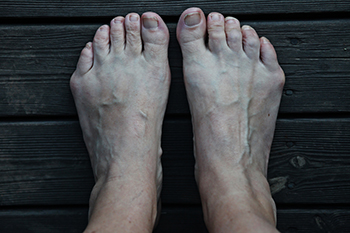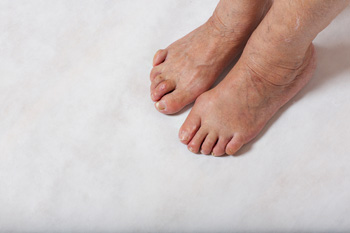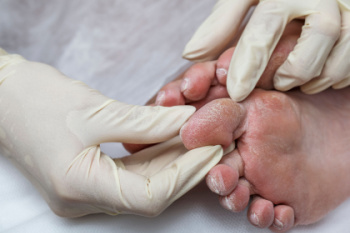
A tailor’s bunion, also known as a bunionette, is a bony bump that forms on the outside of the foot near the base of the little toe. It occurs when the fifth metatarsal bone shifts outward, often due to genetics, improper foot structure, or wearing narrow, tight shoes that squeeze the toes together. Symptoms include a visible bump, redness, swelling, and pain along the outside of the foot. It may feel irritated or sore, especially when walking or wearing tight shoes. Over time, the discomfort can worsen and make regular activities more difficult. A podiatrist can diagnose a tailor’s bunion through a physical exam and X-rays, then recommend a personalized treatment plan. Non-surgical options include padding, footwear modifications, custom orthotics, and anti-inflammatory medications. In severe cases, surgery may be considered to realign the bone and relieve pain. If you are experiencing this condition, it is suggested that you schedule an appointment with a podiatrist for appropriate treatment.
If you are suffering from bunion pain, contact one of our podiatrists of William Street Podiatry. Our doctors can provide the care you need to keep you pain-free and on your feet.
What Is a Bunion?
Bunions are painful bony bumps that usually develop on the inside of the foot at the joint of the big toe. As the deformity increases over time, it may become painful to walk and wear shoes. Women are more likely to exacerbate existing bunions since they often wear tight, narrow shoes that shift their toes together. Bunion pain can be relieved by wearing wider shoes with enough room for the toes.
Causes
- Genetics – some people inherit feet that are more prone to bunion development
- Inflammatory Conditions - rheumatoid arthritis and polio may cause bunion development
Symptoms
- Redness and inflammation
- Pain and tenderness
- Callus or corns on the bump
- Restricted motion in the big toe
In order to diagnose your bunion, your podiatrist may ask about your medical history, symptoms, and general health. Your doctor might also order an x-ray to take a closer look at your feet. Nonsurgical treatment options include orthotics, padding, icing, changes in footwear, and medication. If nonsurgical treatments don’t alleviate your bunion pain, surgery may be necessary.
If you have any questions, please feel free to contact one of our offices located in William Street in New York, NY, Forest Hills, NY, and Broadway in New York, NY . We offer the newest diagnostic and treatment technologies for all your foot care needs.

Toe problems and deformities, such as bunions, tailor's bunions, hammertoes, claw toes, and hallux rigidus, can cause painful symptoms and make walking difficult. These toe-related issues often result from structural problems in the foot combined with pressure from tight footwear or injuries. A bunion causes a large bump at the base of the big toe, while a tailor’s bunion affects the outside of the foot near the little toe. Hammertoes and claw toes involve abnormal bending at the toe joints, creating stiff and painful deformities. Hallux rigidus leads to stiffness and swelling in the big toe joint, often due to wear and tear or injury. In the early stages, a podiatrist may recommend treatments such as orthotics, footwear changes, splinting, or medication to reduce pressure and discomfort. However, as these conditions progress and joints become rigid, surgery may be necessary to realign the bones or repair the affected joints. If you have painful toe problems, it is suggested that you schedule an appointment with a podiatrist for appropriate treatment options.
Toe pain can disrupt your daily activities. If you have any concerns, contact one of our podiatrists of William Street Podiatry. Our doctors can provide the care you need to keep you pain-free and on your feet.
What Causes Toe Pain?
Most severe toe pain is caused due to a sports injury, trauma from dropping something heavy on the toe, or bumping into something rigid. Other problems can develop over time for various reasons.
Toe pain can be caused by one or more ailments. The most common include:
- Trauma
- Sports injury
- Wearing shoes that are too tight
- Arthritis
- Gout
- Corns and calluses
- Hammertoe
- Bunions
- Blisters
- Ingrown toenails
- Sprains
- Fractures (broken bones)
- Dislocations
When to See a Podiatrist
- Severe pain
- Persistent pain that lasts more than a week
- Signs of infection
- Continued swelling
- Pain that prevents walking
Diagnosis
In many cases the cause of toe pain is obvious, but in others, a podiatrist may want to use more advanced methods to determine the problem. These can range from simple visual inspections and sensation tests to X-rays and MRI scans. Prior medical history, family medical history, and any recent physical traumatic events will all be taken into consideration for a proper diagnosis.
Treatment
Treatments for toe pain and injuries vary and may include shoe inserts, padding, taping, medicines, injections, and in some cases, surgery. If you believe that you have broken a toe, please see a podiatrist as soon as possible.
If you have any questions please feel free to contact one of our offices located in William Street in New York, NY, Forest Hills, NY, and Broadway in New York, NY . We offer the newest diagnostic tools and technology to treat your foot and ankle needs.

Diabetic foot complications are serious concerns that can greatly affect quality of life if not properly managed. One major issue is neuropathy, where damaged nerves lead to a loss of sensation in the feet, making it difficult to detect injuries. Poor circulation is another common problem, limiting the blood flow needed for healing and increasing the risk of infections. Skin changes, such as dryness and cracking, create openings for bacteria to enter, further raising the chance of complications. Ulcers may develop on pressure points and can become deep wounds that are slow to heal. Additionally, infections are a major risk and can quickly spread if untreated. If you have diabetes, it is suggested that you are under the care of a podiatrist who can help you to manage this serious condition as it affects your feet.
Diabetic foot care is important in preventing foot ailments such as ulcers. If you are suffering from diabetes or have any other concerns about your feet, contact one of our podiatrists from William Street Podiatry. Our doctors can provide the care you need to keep you pain-free and on your feet.
Diabetic Foot Care
Diabetes affects millions of people every year. The condition can damage blood vessels in many parts of the body, especially the feet. Because of this, taking care of your feet is essential if you have diabetes, and having a podiatrist help monitor your foot health is highly recommended.
The Importance of Caring for Your Feet
- Routinely inspect your feet for bruises or sores.
- Wear socks that fit your feet comfortably.
- Wear comfortable shoes that provide adequate support.
Patients with diabetes should have their doctor monitor their blood levels, as blood sugar levels play such a huge role in diabetic care. Monitoring these levels on a regular basis is highly advised.
It is always best to inform your healthcare professional of any concerns you may have regarding your feet, especially for diabetic patients. Early treatment and routine foot examinations are keys to maintaining proper health, especially because severe complications can arise if proper treatment is not applied.
If you have any questions please feel free to contact one of our offices located in William Street in New York, NY, Forest Hills, NY, and Broadway in New York, NY . We offer the newest diagnostic and treatment technologies for all your foot and ankle needs.


